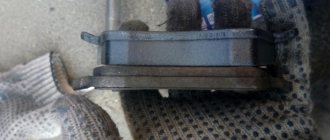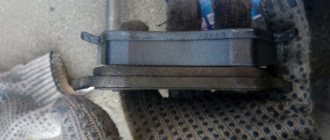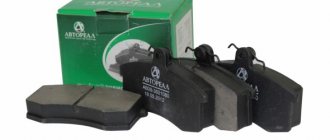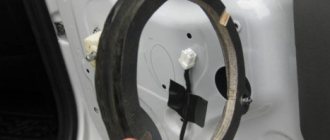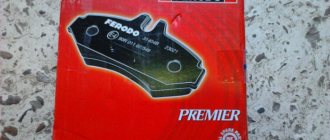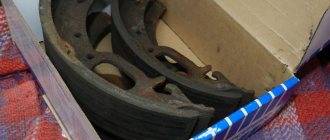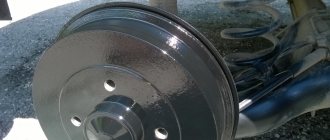Any car slows down due to the fact that the pads press the disc after pressing the brake pedal. The working brake system of a car is a complex mechanism. Front and rear pads for a Lada Vesta car are consumable spare parts that have their own resource and are only part of this mechanism. Vesta, by the way, is a car with good brakes. Because in inventive activities more attention is paid to brakes than to engine modernization - everything is done for the safety of the driver and passengers. Like all parts, the pads, especially the front ones, are not of good quality, sometimes they creak when they are cold. This is due to the quality of workmanship and not a perfect fit to the disk. Poor quality pads can quickly eat up the metal of the disc, or quickly wear out on their own. The braking distance must be minimized, even when the car is traveling at the “maximum” speed. The rear pads come in drum and front disc versions. Depending on the modification, Lada Vesta has both options. But which engine costs 1.6 or 1.8 does not affect the choice of pads at all - they are the same everywhere.
A large load when braking falls on the front pads of the car, which “catch” all the energy on themselves. Parts of the brake mechanisms (especially the front ones) wear out over time, and they wear out even faster if the driver has a jagged driving style with sharp braking to a complete stop. The front pads of the Lada Vesta are good enough to withstand full braking, but even they can be “upgraded”.
wear of the front pad in relation to the old one to the new one
The importance of the service braking system cannot be underestimated. The rear pads of the Lada Vesta experience considerable load when braking and eventually fail. The force with which a car brakes directly depends on the condition of the working brake system, including the rear pads.
RDT (Rear disc brakes) are available in the Lada Vesta SV Cross and Sport modifications. They provide greater braking effect and are more durable due to their design - they overheat less, but have a shorter service life. Drum brakes are available on other versions of the Lada Vesta; they are considered less effective when braking, but longer lasting.
Replacing rear brake pads is more difficult with a drum. The nut must be rotated carefully, otherwise the mechanism will be damaged. Combined with the care with which you have to handle the springs and small parts of the mechanism, you can say that the mechanism is rather weak, but in fact it has been tested over the years and boasts a long service life.
The rear drum mechanism with pads looks like this
Lada Vesta brake pads are recommended to be inspected after 15,000 km. According to the regulations, replacement is carried out after 60,000 km, but experts advise changing them at 30-45 thousand km.
- Standard front pads - article number and price
- What you need to replace brake pads
- Basic faults
- When to change pads on Lada Vesta according to regulations
- Removing and installing front pads
- What front brake pads can be installed on the Lada Vesta - manufacturers, analogue prices
- Rear brake pads Lada Vesta - replacement
- Replacement with calipers
- To replace the rear disc pads of the Lada Vesta you need
- How to change with drums
- What can you tell by the wear of the rear brake pads?
- Analogues on calipers and drums
Standard front pads - article number and price
On a Lada Vesta car of any modification and in any body, consumables manufactured by Renault are installed - be it a sw station wagon, sw cross, sport, etc. On the Lada Vesta St. Cross, the consumable parts can withstand the load - they wear out at the same rate as on other modifications.
Standard components of the Lada Vesta brake system received catalog number 8200 432 336. Their cost in stores starts at 1,400 rubles and ends at approximately 2,000 rubles.
Original or analogue?
This is what AVTOVAZ writes about the original LADA brake discs.
Original brake discs meet high LADA standards and guarantee quality, for this:
- Each batch of brake discs undergoes random inspection and checks of the metal structure using special equipment, excluding porosity and other casting defects
- The disc is made from high-quality cast iron, which guarantees no warping effect during sudden braking or overheating.
- Brake discs undergo high-precision processing to ensure the absence of runout and imbalance
- All original LADA spare parts undergo numerous tests confirming the reliability and quality of each part.
We invite you to determine the best manufacturer. Take the survey and leave your feedback in the comments.
Source
Standard rear brake pads - article number and price
The article number for a set of original pads comes in two types – for drum and disc brakes. The catalog number of the kit for the VAZ Lada Vesta with disc brakes is 11196-3502089-00. It costs about 2000 rubles.
Drums
The kit catalog number for the version with drum brakes is 8450076668. It will cost 4,000 rubles, but, again, it will last longer.
Complete set with calipers
Disc brakes complete with calipers are not sold everywhere, but you can purchase additional calipers. Article - 11196350201100, cost - from 9000, produced by AvtoVAZ.
Basic faults
If we exclude the possible defective parts and poor quality from the manufacturer, then the main reason why the front pads on the Lada Vesta become unusable is wear. They actively interact with other parts of the brake mechanism, and therefore a look at the nature of damage to the friction linings will make it clear what is wrong with the operation of the brake system. By correcting this error, you will increase the service life of not only the pads, but also the entire mechanism.
The nature of the malfunctions can be noted:
- Uniform wear - it manifests itself in the fact that the friction layer is worn evenly, this shows that the brakes are working well.
- Severe wear of the friction layer, brake rivets are visible - this means that you have been using the “outdated” parts for too long. The rivets could damage the disc, so it would be a good idea to inspect it for damage.
- The friction layer is worn evenly around the entire circle, but one of the sides is worn out more than the other - one of the parts of the brake system (guide or piston) does not distribute the braking force correctly. Cleaning all “live” parts and applying a new layer of lubricant will help. Naturally, everything will have to change.
- Both components are worn unevenly, the surface is strewn with irregularities and roughness. The reason for this outcome is a malfunction of the caliper guide pins - they swing and do not give an even trajectory of movement. You will have to clean them, then reapply lubricant.
- The friction lining is cracked - in this case, the “trouble” is caused by the brake discs themselves - they wear unevenly. Everything will have to change.
- Uneven wear of the friction layer means that the parts were installed incorrectly. They will have to be changed.
After performing a visual inspection of the damage, you can independently make a verdict about the breakdown. And besides this, there are several other signs by which you can find out about a faulty front pad while sitting behind the wheel.
Creak
If a squeaking noise occurs from the front when braking, this means that the pad and disc are not mating. This happens when a cheap analogue was purchased to replace the original component. But not everything is so bad - sometimes this analogue can last a long time, but the real reason is dirt that has gotten into the moving parts and reduces the contact area of the moving parts.
Vibration at speed: what is it?
Vibration at speed appears when the pads do not fit the discs - there is some incompatibility that does not manifest itself in the operation of the “original” parts. If, when braking, you still get “full contact” of these parts of the brake mechanism, this means that the wear of the hub discs themselves is haunting, and they will have to be replaced.
Inspection of the body from the Lada Vesta interior
After examining the front panel in the showroom, the car service specialists stated that, judging by the joints and the quality of the materials, it would begin to creak within six months. Experts have noticed that car window seals are not of very high quality; therefore, after some time of using electric windows, scratches from accumulated dust and dirt will appear on the windows.
Replacing headlight bulbs will be convenient. Hands can easily reach the lamps in the engine compartment. But replacing taillight bulbs will be complicated by the fact that it will be necessary to fold back the trunk lining. It is also difficult to find the lamp socket from the taillight. In addition, it is worth noting the presence of plugs in the front fender liners, which make access to the fog lamps easier.
In the table below we show the cost of all repair work on a Lada Vesta car, which was announced by specialists from a private independent car service center.
We replace the pads of a Lada Vesta car in case of maximum permissible wear of their linings - the minimum thickness of the pad, including its base, must be at least 6 mm.
We carry out the work on a flat area, inspection ditch or overpass.
If the fluid level in the hydraulic brake reservoir is at the MAX mark, then before installing new pads, use a syringe or rubber bulb to pump out some of the fluid from the reservoir. This operation must be performed so that when the piston is pressed into the wheel cylinder of the brake mechanism while installing new pads, fluid does not flow out from under the reservoir cap.
Using a metal brush, we clean the spring brackets and pad seats in their guide from dirt and corrosion.
To replace the cover of the upper guide pin, you need to unscrew the bolt of the upper fastening of the bracket to the pin and remove the bracket from the pad guide. Before installing the pin, put a little grease into the hole in the pad guide...
We similarly replace the pads on the other side of the car.
During operation, the surface of the brake disc becomes uneven, as a result of which the contact area of the new, not yet worn-in pads with the disc decreases
Therefore, during the first 100 km of driving after replacing the pads, until the new pads have broken in, be careful, as the car’s braking distance may increase, the pads may get hotter than usual, up to the appearance of light smoke and smell, especially in hot weather.. https: //www.youtube.com/embed/zAOeWh3Efdc. https://www.youtube.com/embed/zAOeWh3Efdc
Sources
- https://autoruk.ru/lada-vesta/tormoza-lada-vesta/remont-perednikh-tormozov-lada-vesta
- https://motormania.ru/auto-pomosh/lada-vesta-stoimost-rabot.html
- https://www.zr.ru/content/articles/852978-lada-vesta-zamenyaem-kolodki-tormoznyx-mexanizmov-perednix-koles/
Removing and installing front pads
Before starting work, prepare the following tools:
- Keys for 13 and 15;
- Brake system parts cleaner (a regular rag will not be able to completely remove dirt and used lubricant residues);
- Flat screwdriver;
- High temperature grease.
The procedure for replacing parts is as follows:
- Secure the vehicle in place by applying the parking brake. Turn off the ignition. Raise the front of Vesta with a jack;
- Proceed to remove the wheel. Remove the cap, loosen the bolts one turn. Continue this action in a circle with all the bolts;
- Remove the brake fluid reservoir cap and pump out a few milliliters. This will prevent the liquid from coming under pressure. Press the brake cylinder inward with a screwdriver;
- Use a 15mm wrench to hold the caliper guide pin, and use a 13mm wrench to remove the two bolts. Do not let the free part of the caliper fall to the ground;
- Pry up the outer pad with a screwdriver and carefully remove it. In the same way, remove the inner block;
- The spring retainer, which is responsible for uniform wear, will have to be cleaned and then re-coated with lubricant;
- Install a new part - first the external one, then the internal one;
- Clean the guides and also coat them with lubricant;
- Put all the parts back;
- Tighten the fastening bolts, install the wheel, clockwise, one rotation at a time, secure all the bolts.
What front brake pads can be installed on the Lada Vesta - manufacturers, analogue prices
The following analogues of front pads are common:
- Front brake pads HI-Q Sangsin Brake (SP 1564) – 1400 rubles;
- SAT (ST4106000Q0K) – 450 rubles;
- Brembo (P68033) – 1600 rubles;
- Galfer (B1G10207412) – 1250 rubles;
- Zekkert (BS-1221) – 700 rubles;
- Blitz (BB0292) – 750 rubles;
- Hagen Sangsin Brake (GP 1564) – 1400 rubles;
- UBS (BP1105007) – 1500 rubles;
- ATE (13.0460-2709.2) – 1700 rubles;
- LYNXauto (BD5739) – 850 rubles;
- TRW (GDB 3332) – 1700 rubles.
Rear brake pads Lada Vesta - replacement
The moment to replace and repair the rear pads on a car is determined by the fact that they are in a state of maximum permissible wear. You should also start planning a replacement if the linings are oily, or if chips, cracks and damage are visible on them, as well as a gap between the base of the consumable and the lining.
It is important to understand that the consumables on the rear wheels need to be changed as a set - so that the force is uniform, otherwise the car may skid when braking, and the braking itself will be ineffective. You need to install all four parts.
How does Lada take care of your safety?
Lada Vesta has a special adaptive system in its arsenal, which is designed to ensure maximum convenience of the braking process. The car has built-in electronics that determine how fast and how hard the driver presses the pedal. This allows you to achieve the fastest and most timely stopping of the car in any situation. The computer has an instant response and takes care of the safety of the driver of the Lada Vesta continuously throughout the entire trip.
Lada Vesta is also equipped with a built-in electronic system designed to distribute forces. It turns on at the moment when the load on the disc and drum brakes goes beyond the established norm. This system redistributes the load level, and Lada Vesta continues to move without skidding.
In addition to all the innovations listed, the Lada Vesta has a directional stability system, which is responsible for the following vehicle functions:
- if necessary, certain (depending on the situation) wheels of the Lada Vesta independently brake and create optimal conditions for movement;
- torque may vary;
- the front wheels of Lada Vesta are independently redirected in the correct direction.
Such properties allow the Lada to keep the right course during sharp turns. The trajectory of movement does not deviate from the norm due to the braking of the rear wheel located inside. The use of this technology allows the driver to have good control of the Lada Vesta at all times.
Replacement with calipers
Replacement with calipers is carried out in the same order, only at the stage when the entire mechanism is disassembled, using keys 13 and 15 you need to remove the caliper and put new parts in its place.
To replace rear disc pads on a Lada Vesta you need:
- Place the car on the ramp and lock it in gear;
- Bring the brake fluid level to a little less than half;
- Raise the rear of the machine and secure it with the support stand. Remove the wheel;
- Install the disc removal tool from the hub;
- Place the central part on the axle, and the rest will create pressure on the disk;
- If something won't come off, treat it with wd-40. Remove the bolt that secures the disc to the hub. Do this carefully, because if the edges of the bolt come off, it will be more difficult to remove;
- Remove the brake pads;
- Check the condition of the brake system. Put the new components in place and reassemble everything in reverse order;
- Bring the brake fluid level to about and adjust the brake pedal.
Replacing the rear wheel brake working cylinder
Place the car on a lift and apply the parking brake to the rear wheels.
Remove the rear wheel.
Release the handbrake lever.
Remove the brake drum.
Remove the upper tension spring.
We spread the brake pads.
We unscrew the fitting securing the brake pipe 4, Figure 4, to the wheel cylinder 2 of the rear brake and install plugs on the brake pipe and in the hole in the wheel cylinder.
Using a 10mm socket, unscrew bolts 3 securing wheel cylinder 2 to rear brake shield 1 and remove the cylinder.
Installing the slave cylinder
Clean the rear brake elements.
We install the wheel cylinder on the rear brake shield and secure it with bolts. The tightening torque of the bolts is 7 - 11 Nm (0.7 - 1.1 kgf.m).
We remove the plugs from the holes in the wheel cylinder and the brake pipe and screw the brake pipe fitting into the hole in the wheel cylinder. The tightening torque of the fitting is 14 - 20 Nm (1.4 - 2.0 kgf.m).
Install the upper tension spring.
Install the spacer bar.
Check the outer diameter of the brake pads and adjust if necessary.
Install the brake drum as indicated above.
Install the rear wheel.
We bleed the brake system and, if necessary, the hydraulic clutch.
After this, we check the effectiveness of the brakes.
I can’t help but praise Vesta in motion: its handling is just right. Both at 100 kilometers per hour and at 140 it’s pleasant to drive this car. But I would gladly replace the “robot” with its tendency to kick and thoughtfulness with “mechanics” or a hydromechanical “automatic”.
The rear suspension, even on tram rails, gave a kick to the “butt”; on “speed bumps” it worked before the lights out, responding with unpleasant blows. Of course, handling is paramount, but for our roads I would like something with a longer stroke.
What will the masters say about the salon? We spent a long time feeling the panel, and were most interested in the joints and materials. They promised that in six months it would begin to creak. Let's see, it's quiet in the cabin.
The sound of the driver's door window rising and falling made them fear for the future safety of these same glasses: dust and dirt accumulate in the seals, which can cause scratches to quickly appear.
They listened to the movement of the dampers of the climate control unit like doctors listened to the patient’s heartbeat. Yes, the damper sounds are strange. When changing direction, say, from the glass to your feet, a quiet crunching sound is heard.
In general, the interior is, of course, comfortable and so far evokes positive emotions. We can attribute some minor shortcomings to the fact that this is not a C or D-segment car. There is nothing criminal, nothing falls off or unscrews. We just have to look at at least replacing the light bulbs.
Sources
- https://autoruk.ru/lada-vesta/tormoza-lada-vesta/remont-tormoznykh-mekhanizmov-zadnikh-koles-lada-vesta
- https://www.kolesa.ru/lada/jeto-vam-ne-zhiguli-obsluzhivanie-i-remont-lada-vesta-2015-12-25
How to change with drums
You can remove the old ones and install new rear drum pads on the Lada Vesta using the following algorithm:
- Place the car on the overpass and turn off the handbrake. Secure the car by putting it in gear. It is better to reduce the brake fluid level and make it a little less than half of the norm.
- Raise the rear of the car slightly and secure it with a support stand. Remove the wheel.
- Using a flat-head screwdriver, rotate the ratchet nut away from you (“pushing” it along the thread). This reduces the length of the spacer bar and brings the pads together.
- Insert the chisel under the cap and use a hammer to knock down this cap protecting the drum bearing.
- Unscrew the hub bearing nut using a 30 mm socket.
- Carefully remove the brake drum along with the bearing. Notice the anti-lock brake sensor at the bottom under the ratchet nut (it looks like a small black plastic lever). Your task is not to damage it.
- Take a screwdriver, pry the release spring behind the hook, and then the stand. Take them off. Also remove everything on the front pad.
- Using the same screwdriver, pry the lower tension spring by the hook and remove it.
- Try not to damage the cylinder boots.
- Hook the upper tension spring on the hook and remove it from its engagement with the front block, and then dismantle it.
- Remove the front block and then the bar from the mechanism.
- Disconnect the end of the handbrake cable from the rear shoe lever.
- Before assembling the mechanism, the rear tip of the spacer bar must be recessed - the length of the spacer bar will be minimal.
- Brush the working surface of the drum with a wire brush to remove dust and dirt. Use the brush to avoid touching the ABS sensor reference ring.
- Install the mechanism in reverse order.
- Tighten the hub bearing nut to 175 Nm. As a recommendation, it is worth mentioning that it is better to install a new self-locking nut.
- After the work has been carried out, it is worth checking the brake fluid level in the reservoir.
- It is important to place the parts in the correct working position. Press the brake pedal several times and then hold it in the down position.
- Raise then release the handbrake (but only with the button engaged to deactivate the ratchet).
- Instead of handbrake clicks, you will hear other clicks - this is how the gap in the brake mechanism between the discs (drums) and pads is adjusted. Repeat these steps until the clicking noise disappears. If necessary, adjust the parking brake.
2283-14-03-01
To do this, use a slotted screwdriver to rotate the ratcheting nut of the mechanism for automatically adjusting the gap between the pads and the drum through the threaded hole in the brake drum, thereby reducing the length of the spacer bar.
To do this, use a slotted screwdriver to rotate the ratcheting nut of the mechanism for automatically adjusting the gap between the pads and the drum through the threaded hole in the brake drum, thereby reducing the length of the spacer bar.
What can you tell by the wear of the rear brake pads?
Pad wear means:
- Wear of the friction layer;
- Damage to the friction layer (for example, cracks);
- Friction layer bevel;
- Carbon deposits on the discs or drum.
These “illnesses” can appear when:
- Light knocking sound when braking. This should not be confused with ABS;
- Poor braking efficiency;
- Whistling, grinding noise when braking;
- Dust, chips on the discs.
Any car repair operation is a treatment. But a separate operation may not be a treatment, but a concealment of the symptoms of a real disease. If consumables are changed due to their “natural death” - the mileage mark has simply reached 60,000 km, then other parts of the mechanism clearly should not be blamed for this.
But if the consumables failed earlier, then replacing them may not solve the problem, and soon you may have to change not only them, but also other parts of the mechanism. This is due to another malfunction in the mechanism:
- Insufficient brake fluid level;
- Caliper malfunction (causes uneven wear of the friction layer), insufficient amount of lubricant or unsuitable lubricant;
- Faulty guides (for example, damaged boot);
- Incorrect adjustment of the service brake system, failure to release the handbrake;
- Low quality friction layer;
- Damage to oil seals;
- Depressurization (airing) of the mechanism;
- Uneven operation of hydraulic cylinders supplying unequal forces;
- Brake hose leak;
- ABS jamming;
- Warped brake disc.
DSC_9301
The spacer bar is a rather complex mechanism, which, if the elements are damaged or significantly corroded, is best replaced.
If the condition of the spacer bar is satisfactory, then it should be washed in any solvent and a thin layer of grease should be applied to the threads. The spacer bar is a rather complex mechanism, which, if the elements are damaged or significantly corroded, is best replaced. If the condition of the spacer bar is satisfactory, then it should be washed in any solvent and a thin layer of grease should be applied to the threads.
Analogues on calipers and drums
There are analogues for Lada Vesta drum brakes on the market:
- Fenox (BP53013). Cost 980 rubles; (BP53168) Price 1340 rubles;
- Hella Pagid (8DB355002-411). Price 2780 rubles;
- JP Group (1563900810). Price 1490 rubles;
- Mintex (MFR516). Price 2550 rubles;
- Patron (PSP8742). Price 730 rubles;
- Remsa (4137.00). Price 1110 rubles;
- Textar (91057300). Price 3130 rubles.
There is an analogue of Lada Vesta disc brakes. It is produced by TRW, article number gdb1384, cost – 1400 rubles.
